But I also admit to a certain dislike for the modern Russian restaurant. See, it can't bring itself to be solely a restaurant. Whether in Russia or the United States, it often doubles as a disco, like the month-old Russian Fairytale, which overlooks Biscayne Bay from its 79th Street Causeway location. It has to have a spinning disco ball and flashing lights. It has to have a dance floor. It has to have a live band performing everything from traditional Russian folksongs to Dire Straits covers. Yet the waiters are dressed in traditional garb, detailed murals span the walls, and a showcase in the foyer is filled with palex-style (hand-painted) Russian artifacts, all of which bespeak centuries of history.
Discos, a link to Western culture, are still very popular in Russia, and they haven't changed much since the Seventies. (South Beach club kids searching for retro music, please go abroad and take note.) It's only natural that this style of restaurant should be re-created in Miami, where a Russian community thrives. I just wish Russian Fairytale's owners, a corporation, would turn down the blaring lights and music during weeknight dinner hours, when a curious, first-time patron such as myself isn't necessarily looking for a party.
On the other hand, I admired several elements of this 200-seat restaurant, which took over the site of Landry's (an upscale national seafood chain whose Miami branch never impressed me). Noritake china and cut crystal glassware -- highball glasses for water, cordial glasses for vodka -- set the tables. Fresh rolls shaped like bialys with holes in the middle are served with hand-scraped curls of butter in a glass dish. Plates are covered with warming lids. Service is deferential, as if each diner were a czar or czarina.
I especially liked the menu, a conglomeration of regional recipes that screamed Grandma Karetnick's kitchen right off the bat, with appetizers such as braised chicken livers with sour cream, and pelmeni, my all-time favorite. These Siberian meat dumplings also go by the names of pierogi, samsa, and kreplach, depending on the region of Russia in which they're being made. I used to help my grandmother make kreplach, but I have to admit that the results were fairly leaden (sorry, Grandma). In contrast, the Fairytale's translucent dumplings were stuffed with a juicy mixture of ground beef and pork, then boiled and served with rich sour cream. (You can also order them pan-fried, which makes them resemble their Asian dim sum counterparts.)
Another hot starter, roll-'em-yourself salmon blini, cooled off quickly, so quick eating was in order. The buckwheat pancakes were a little too thick and sweet, however, to mesh ideally with the lacy smoked salmon and too salty red caviar that were piled on the plate next to them. Condiments of lemon wedges and sour cream helped freshen the fish and soothe the palate from the sharp sting of the caviar.
We had no complaints about a flavorful bowl of cabbage soup. Stocked with lean pork and shredded cabbage, the broth was aromatic with bay leaves. A pretty puff of baked dough covered the crock; the idea was to poke through it and drop bits of the pastry into the warm soup below for softening. Sour cream was also provided.
No matter how many starters you order or how large the main courses turn out to be (pretty large, in this case), you should always try to leave room for zakuski. Literally translated as "small bites," zakuski (pickles, vegetable salads, caviar, pates, and cured fish fillets) were traditionally used to welcome guests into the home; now they're treated, like a house salad, as something of a transition between more substantial courses. At Russian Fairytale you can find zakuski under the heading "cold appetizers." We selected raznosol, a mixed plate of pickled cucumbers and cabbage. The cucumbers were appropriately salty and tangy, the cabbage vinegary but mild. The platter also contained a whole, peeled, pickled red tomato and a generous portion of shredded carrot-and-garlic salad.
If caviar is considered a transitional dish, then I guess sturgeon (the adult version of caviar) is the authentic follow-up course, along with salmon and shad, other fishes found in northern climes. I opted for lake trout, served whole (skin, tail, eyes, and everything) with "Slavonic sauce." The waiter couldn't tell me what Slavonic sauce was but suggested I get it on the side in case I didn't like it. The sauce turned out to be a butter-rich condiment rife with red peppers and capers, and was the tastiest part of the meal. The boned trout, stuffed with sauteed mushrooms and onions, had a less-than-fresh taste and was overcooked just a tad. Crisp, pan-fried, sliced potatoes and a vegetable melange that had a prefab, Green Giant appearance and overboiled flavor accompanied the fish.
Matters improved with meat entrees. Veal with sauteed onions and mushrooms turned out to be a large chop rather than the medallions we had anticipated. Pan-fried, the veal was pleasantly meaty and lean, topped with the caramelized onions and partnered by the aforementioned potatoes.
Gusarskaya ruletka proved to be the most expertly prepared main course we tried. Five lamb chops were crusted with cheese-laden bread crumbs, grilled to a medium-rare, and placed on a zippy mustard sauce. A tomato -- stuffed with sauteed eggplant and topped with broiled breadcrumbs -- garnished the lamb, offering a nice textural balance to the heartier meat.
Vodka is a palate-cleansing way to wash down your food at any time during the meal, but kvas might actually be more refreshing. Susan Ward, author of Russian Regional Recipes, calls this beverage a "near beer." Kvas is made by fermenting wheat, rye, and buckwheat with water and sugar; one of my guests likened its flavor to cider, another to a fresh-cut lawn. I liked the whimsical way it was served -- in a glass shaped like a boot.
We weren't amused by dessert, however. Russkaya troyka, two slices of log cake and a tart, all of which contained candied fruit, were stale and refrigerator-burned. Next time I'll drink my dessert in the form of kisel, a summery, fruity juice spiked with wine (like sangria). And between the kisel, the kvas, and the vodka, maybe I won't mind the disco fever so much.
Russian Fairytale
1601 79th St Cswy, North Bay Village; 864-8080. Lunch and dinner Tuesday -- Sunday from noon to 3:00 p.m. and from 6:00 p.m. until 1:00 a.m.
Pelmeni
$7.85
Salmon blini with caviar
$14.95
Trout with Slavonic sauce
$17.45
Lamb chops
$29.90
Russkaya troyka
$4.85










